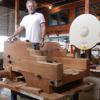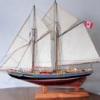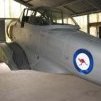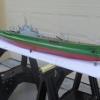Supplies of the Ship Modeler's Handbook are running out. Get your copy NOW before they are gone! Click on photo to order.
×
-
Posts
7,403 -
Joined
-
Last visited
Reputation Activity
-
 Mirabell61 reacted to JerryTodd in Constellation 1856 by JerryTodd - 1:36 scale - RADIO - First Class Sloop of War
Mirabell61 reacted to JerryTodd in Constellation 1856 by JerryTodd - 1:36 scale - RADIO - First Class Sloop of War
I hung the courses (with clothespins) after hemming them.
While in hemming mode, I did the last two sails in her suit; the main and fore trys'ls. I burned all the grommets in with a soldering iron since this pic was taken.
These sails (courses and trys'ls) will be brailed up as I don't have a good way to control them via RC. The courses I hope to figure out eventually, but the trys'ls won't be happening. I'll shake them out for static displays.
I want to use the tacks to haul the clews forward as the best control when close-hauled. The best way to do that is with a trolley system, like a clothesline, with a winch running a continuous loop and the tacks attached to that loop. The sheets just run through the model from one clew to the other.
There's a couple of problems here. The main and fore sails are controlled separately, so I'd need TWO of these set-ups inside the model, which accents the second problem; space (room, accessibility through hatches, and the spider's web of control lines already in place. A more compact solution would be a "linear actuator" or basically a threaded rod spun by a motor with the tacks attached to a shuttle that travels on the rod.
Either way, the trolleys or actuators would have to be as long as at least half the length of tack I need to haul, which would probably be around 6 to 10 inches.
The real thing here is, besides adding two more electric motors to the load and dealing with directional control, etc; syncing it with the winches that control the braces for the same mast.
Another much simpler way of dealing with the courses, is the "Bentinck-boom," which is simply a yard at the bottom of the sail. The foot of the courses gets pulled around like the rest of the yards not directly controlled. Rather than an actual yard, it would be a rod set into the foot of the sail to have the same effect. This is ok if it's in a pocket and I can remove it easily to clew up the sail when I want to.
Another version of this is to use stiff wire or rod made to appear like the clew-lines, that hold out the clews as the boom would. This seems it would be more difficult to make removable when I want clew up the sail than the boom version would.
Soooooooo....
I guess I'll wind up going with the "Bentinck-boom" rod in the foot of the sail idea, but I'm not going to worry about it until I get the rope-walk operating and can get down to properly rigging this beast.
-
 Mirabell61 reacted to JerryTodd in Constellation 1856 by JerryTodd - 1:36 scale - RADIO - First Class Sloop of War
Mirabell61 reacted to JerryTodd in Constellation 1856 by JerryTodd - 1:36 scale - RADIO - First Class Sloop of War
I've seen several servo hacks designed to have them run continuously, such as you might want for a winch. If I did this to a pair of cheap servos, I could Y them off the brace winch servos and they should operate together. This is something I'll experiment with down the road. Today I dunked sticks in ammonia and wrapped them around a tube to make hoops for the two trys'ls. While that dried I went to a friends and helped him eat the crabs he caught this morning.
26 more hoops like these for the driver
It's been running in the 80's here for the past week, temperature-wise; that just broke this evening with rain, wind, and dropping down to 60° (f). Ready or not, when the these winds blow out, I'm hauling the boat out and putting her in the water. I want some pictures of her afloat with all her sail's aboard, and I want to test launching and retrieving with the new cart a few times.
-
 Mirabell61 reacted to JerryTodd in Constellation 1856 by JerryTodd - 1:36 scale - RADIO - First Class Sloop of War
Mirabell61 reacted to JerryTodd in Constellation 1856 by JerryTodd - 1:36 scale - RADIO - First Class Sloop of War
Well, I managed to get a sail in before it got cold.
I had a short list of items to "test" with this expedition...
Boat will fit in my Toyota Matrix. Launch trailer worked well, needs some tweaks to keep the boat from sliding off the end before you want it too, and there's too much slop in the flag-bracket handle holder. Self-tending bowlines worked well. Bracing only the tops'l yards worked well. Jib-sheeter worked well despite not being adjusted as best it could have been. Finally sailing in open water again where she was intended to be since I started her in 1999. I held my breath every time a gust made her heel. She did great. Remember to bring extra batteries for the camera next time. I brought tools, line, tape, glue, reading-glasses, tripod, and the camera batteries died. Fortunately Captain Rooney was on hand and took some stills and video with his phone, while sailing Son of Erin and keeping an eye on the two grand-kids - but he's a tug captain and used to multi-tasking. Here's some pics from today's outing.
and 16 minutes or so of video...
-
 Mirabell61 reacted to EdT in Young America 1853 by EdT - FINISHED - extreme clipper
Mirabell61 reacted to EdT in Young America 1853 by EdT - FINISHED - extreme clipper
Young America - extreme clipper 1853
Part 180 – Bowsprit
So, after three years and179 parts to this build log it is finally time to get off the deck. Making the largest spars – lower masts and bowsprit – is the first order of business.
In shaping all the spars for the model, I expect to generally follow the methods used by the original spar makers – except of course for the tools. I expect to take some liberties with the made masts, but that will be covered later. There are many steps involved in getting from a model "tree" to a finished spar. I do not intend to cover them in detail here, but merely to provide an overview. Even at that, this posting on the bowsprit has nine pictures and a fair amount of text.
I started with the bowsprit as perhaps the simplest of the large spars. At 47' long and 36" maximum diameter it was undoubtedly made from a single tree – probably of long leaf (yellow) pine. The first picture shows the spar after the "first trimming" – the point at which the tree has been squared to the spars maximum diameter and cut roughly to length.
The piece has been marked on all four faces at the ends and at the four "quarters" forward of the "partners" – that is in this case, the knightheads. The square section inside the knightheads has been marked. Centerlines have been drawn on all four faces.
In the next picture the breadths at each quarter and the ends are being marked on one face only with dividers set from the drawing.
In the next picture the "second trimming" is being made on the disk sander.
Two opposite faces are being trimmed back to the measurements made above. This tool helps keep the cuts perpendicular and fair. The next picture shows the spar after the second trim. It shows the tapers at the ends on two opposing sides only.
These cuts were made just slightly full so they could be safely finished to the final dimensions in later steps. The calipers and the calculator are key tools for this. The converted dimensions may be seen in pencil on the drawing. In the picture the trimmed faces have been marked with centerlines and quarter marks. The breadths at each point were then marked on the trimmed faces, so the "third trimming" could be made on the remaining two sides – also on the disk sander as before. The bowsprit after the third trim is shown fitted part way in position between the knightheads.
The next step – the fourth trimming – converts the still square areas (except at the partners) to an intermediate octagonal shape. The trimming is done by hand – planes, rasps, files, scraper plate. To provide some rough guide lines for that work, the tool shown below was useful.
The apices of an octagon are 7/24 of the diameter in from the sides of the square at each point along the curve. The tool shown has a scriber point at 7/24 distance from one of two end guides. By angling the tool as it is drawn along the spar, a 7/24 line is scribed. This takes some practice and is a rough measure – but a very helpful one. With lines marked on each face of the square section, the octagonal flats were cut and the spar trimmed as shown below.
A lot of caliper measurements and fine trimmings are required to get the spar to this point. The diameters of all the faces at each point are measured and trimmed to size. The final, "fifth trimming" is being made below.
The apices are being filed off and the spar rounded. Again the diameters at each mark are checked. Roundness along the spar was checked using a draftsman's circle template to spot high areas. The last picture shows the bowsprit fitted temporarily with its tenon seated in the step above the main deck.
In the picture the bowsprit has been sanded but not polished and the tenon for the cap is not yet cut.
Ed
-
 Mirabell61 reacted to michael mott in Albertic by michael mott - FINISHED - Scale 1:100 - RESTORATION - Bassett-Lowke Model
Mirabell61 reacted to michael mott in Albertic by michael mott - FINISHED - Scale 1:100 - RESTORATION - Bassett-Lowke Model
Thanks Jack, yes as long as I can sit at the desk and putz I'm OK yesterday I plotted the positions of all the anchors on the funnel deck so now I can plot all the funnel stay lengths. they are all going to need replacing regardless of the individual few that are OK just so that they are all consistent colour and wind wise.
I recall I think it was Bob in Arizona who set up the rigging on one of his boats by working at them off the model, I am going to do the same thing That way I will be able to just insert the eyes at the deck into slightly loose holes with some glue rather than forcing them back into tight holes.
I will prepare a dummy funnel deck so that I can access the stays easily at the edges while working them.
Michael
-
 Mirabell61 got a reaction from ggrieco in SS Kaiser Wilhelm der Grosse 1897 by Mirabell61 - FINISHED - scale 1:144 - POF - first German four stacker of the Norddeutscher Lloyd line
Mirabell61 got a reaction from ggrieco in SS Kaiser Wilhelm der Grosse 1897 by Mirabell61 - FINISHED - scale 1:144 - POF - first German four stacker of the Norddeutscher Lloyd line
Hi Denis,
thats the spaces for air collection- and distribution boxes....
below the deck are situated Pantry (kitchen) and smoker`s lounge
Nils
4 skylights and 7 vents on this little platform
-
 Mirabell61 got a reaction from canoe21 in SS Kaiser Wilhelm der Grosse 1897 by Mirabell61 - FINISHED - scale 1:144 - POF - first German four stacker of the Norddeutscher Lloyd line
Mirabell61 got a reaction from canoe21 in SS Kaiser Wilhelm der Grosse 1897 by Mirabell61 - FINISHED - scale 1:144 - POF - first German four stacker of the Norddeutscher Lloyd line
Hi Denis,
thats the spaces for air collection- and distribution boxes....
below the deck are situated Pantry (kitchen) and smoker`s lounge
Nils
4 skylights and 7 vents on this little platform
-
 Mirabell61 got a reaction from ggrieco in SS Kaiser Wilhelm der Grosse 1897 by Mirabell61 - FINISHED - scale 1:144 - POF - first German four stacker of the Norddeutscher Lloyd line
Mirabell61 got a reaction from ggrieco in SS Kaiser Wilhelm der Grosse 1897 by Mirabell61 - FINISHED - scale 1:144 - POF - first German four stacker of the Norddeutscher Lloyd line
Update
machine room skylights complete....
Nils
-
 Mirabell61 reacted to jack.aubrey in Gaeta Falcata (Gajeta Falkusa) by jack.aubrey - FINISHED - Marisstella - 1:20 Scale
Mirabell61 reacted to jack.aubrey in Gaeta Falcata (Gajeta Falkusa) by jack.aubrey - FINISHED - Marisstella - 1:20 Scale
Thursday, October 27, 2016
A small step forward. .
Today I proceeded to glue together all the three main elements of the keel. To insure their correct positioning, I proceeded to glue under them a photocopy of the drawings where the keel is visible. This because the keel is not perfectly straight but is slightly curved and only the plan give the right way. Now it remains to apply a strip 5 x 1.5mm which will form the false keel to complete. At this point the keel can be positioned on the hull skeleton. All joints are refined and tested.
A couple of views of the keel, with all its elements: the keel, fore foot, stem, apron of the stem, stern and stern knee.
01 - 20161027_155255.jpg
02 - 20161027_155334.jpg
Meanwhile the hull structure has been enriched by new elements that hold the complex together and stiffen it.
It is necessary to emphasize here that this entire structure, except for reinforcements 16.1, 16.2, 16.3 and 16.4 which are glued together, stays together not thanks to glue but for all its joints. The keel also, once positioned, will not be glued but only stuck.
It is therefore essential that all the joints are perfect, neither too wide, otherwise they would not hold all together, neither too tight, otherwise there is the risk of possible deformations. The planking must also be done in a way that it's carried mainly between a strake and its adjacent, using the bulkheads only as a support but possibly avoiding glue. An alternative method is to apply on the thickness of the bulkheads a plastic tape. This is because, once the planking is over, you should be able to easily detach the shell (planking lus keel) from the skeleton shown below.
03 - 20161027_155152.jpg
04 - 20161027_155210.jpg
See you tomorrow . . Jack.
-
 Mirabell61 reacted to jack.aubrey in Gaeta Falcata (Gajeta Falkusa) by jack.aubrey - FINISHED - Marisstella - 1:20 Scale
Mirabell61 reacted to jack.aubrey in Gaeta Falcata (Gajeta Falkusa) by jack.aubrey - FINISHED - Marisstella - 1:20 Scale
Monday, October 24, 2016
While I was assembling together the elements of the keel I started also to prepare a first building slip that, for this model, I believe is even of greater importance than in my previous experiences, perhaps excluding the Viking ship. In fact this model was thought by MarisStella as a mean for planking the hull with the bulkheads facing downwards.
This building slip is made with a plywood board of 2cm on which I wrote the position of the bulkheads and the central element that aligns them. To keep in the correct position this element I applied some wood guides positioned properly.
Here two images of the building slip, as it is now. I do not exclude some modifications and/or additions later.
01 - 20161025_090412.jpg
02 - 20161025_090418.jpg
Here below, three later images of the slip with some pre-cut laser elements of the kit already positioned. Thay make up the hull skeleton.
03 - 20161024_164728.jpg
04 - 20161024_164720.jpg
05 - 20161024_164658.jpg
That's all for today, to the next issue . . Jack.
-
 Mirabell61 reacted to jack.aubrey in Gaeta Falcata (Gajeta Falkusa) by jack.aubrey - FINISHED - Marisstella - 1:20 Scale
Mirabell61 reacted to jack.aubrey in Gaeta Falcata (Gajeta Falkusa) by jack.aubrey - FINISHED - Marisstella - 1:20 Scale
Monday October 24, 2016
I'm starting with the most classic and intuitive boat component: the assembly of the various elements that together make up the keel.
There are here three main pieces, of which the first two are the most structured: the stern . .
01 - 20161024_164802.jpg
the bow . .
02 - 20161024_164808.jpg
and the central body that connects the two ends.
The material used for the keel is made from a walnut tablet 4mm thick.
The pieces fit together perfectly and so there were no significant adjustments to make.
The only activity necessary by now was the removal of the "burnt" of laser cutting. In fact, I noticed that this burned surface, if not previously removed, was making the PVA glue working badly.
03 - 20161024_164756.jpg
In short, a few minutes homework . . Regards, Jack.
-
 Mirabell61 got a reaction from PeteB in SS Kaiser Wilhelm der Grosse 1897 by Mirabell61 - FINISHED - scale 1:144 - POF - first German four stacker of the Norddeutscher Lloyd line
Mirabell61 got a reaction from PeteB in SS Kaiser Wilhelm der Grosse 1897 by Mirabell61 - FINISHED - scale 1:144 - POF - first German four stacker of the Norddeutscher Lloyd line
Hi Denis,
thats the spaces for air collection- and distribution boxes....
below the deck are situated Pantry (kitchen) and smoker`s lounge
Nils
4 skylights and 7 vents on this little platform
-
 Mirabell61 reacted to tadheus in La Salamandre by tadheus - 1:24
Mirabell61 reacted to tadheus in La Salamandre by tadheus - 1:24
Karl, Nils, Geert, Jim, Aviaamator, thank you. .
I used to milling cutter for metal thickness of 4 mm.
The beginning of the relation is available at this address:
http://5500.forumact...ndre-1-24#66516
Regards, Pawel
-
 Mirabell61 reacted to KeithAug in SS Kaiser Wilhelm der Grosse 1897 by Mirabell61 - FINISHED - scale 1:144 - POF - first German four stacker of the Norddeutscher Lloyd line
Mirabell61 reacted to KeithAug in SS Kaiser Wilhelm der Grosse 1897 by Mirabell61 - FINISHED - scale 1:144 - POF - first German four stacker of the Norddeutscher Lloyd line
Her beauty continues to grow Nils.
-
 Mirabell61 reacted to Angarfather in SS Kaiser Wilhelm der Grosse 1897 by Mirabell61 - FINISHED - scale 1:144 - POF - first German four stacker of the Norddeutscher Lloyd line
Mirabell61 reacted to Angarfather in SS Kaiser Wilhelm der Grosse 1897 by Mirabell61 - FINISHED - scale 1:144 - POF - first German four stacker of the Norddeutscher Lloyd line
Hello Nils!
what a forest of vents on the boatsdeck!!!! In my office there is an old, photo of the "Kaiser". A very heroic picture of the "proud of the merchant navy". But without such inconsistencys like vents.
Very impressive work!!
Cheers Hartmut
-
 Mirabell61 reacted to popeye the sailor in SS Kaiser Wilhelm der Grosse 1897 by Mirabell61 - FINISHED - scale 1:144 - POF - first German four stacker of the Norddeutscher Lloyd line
Mirabell61 reacted to popeye the sailor in SS Kaiser Wilhelm der Grosse 1897 by Mirabell61 - FINISHED - scale 1:144 - POF - first German four stacker of the Norddeutscher Lloyd line
makes it look more complete............wonderful work!
-
 Mirabell61 reacted to michael mott in Albertic by michael mott - FINISHED - Scale 1:100 - RESTORATION - Bassett-Lowke Model
Mirabell61 reacted to michael mott in Albertic by michael mott - FINISHED - Scale 1:100 - RESTORATION - Bassett-Lowke Model
Nils I have some brass coloured control line wire in both .018" and .032" the original B&L wore is .028"
The hidden damage is now becoming more apparent.
I am also of the opinion now that this ship has been knocked pretty hard on some earlier occasion.the following pic shows two concerns I have
within the highlighted area the cargo winch deck is sprung that is the same on both port and starboard. you can see that the underside of the deck is unfinished and not very clean.
The area below and just above the brass hatch is bulged a little and this is an old repair it is only on the starboard side.
My concern is that the cargo deck is flexible enough that I should be able to pull it back down into alignment by using the vent stacks as a clamp by fixing the base ring that sits on the deck so that as the vent is reseated into the main block of the hull deck the black rings which are loose would pull down the deck.
Both the foremast shrouds and the stern-mast shrouds are loose and I am reluctant to tighten them to make them look clean because they will put an additional strain on the already compromised decks.
here you can see that the lifeboat deck at the bow is bent upwards in the same way as the deck at the stern, no doubt that pressure on the shrouds during the fall contributed to this.
This brings me back to the funnels
I think that having the shrouds and stays more rigid and made to exact lengths and replacing all of them might end up giving the best solution. The following picture shows a new stay using the .032" brass control line wire it is brass plated steel. with some of the Bassett Lowke wire used as a serving to emulate the same look but neater.
I could do this with all the standing rigging, it even has the wrong lay up as the B&L
help I'm falling down the rabbit hole........
Michael
-
 Mirabell61 got a reaction from Piet in Cutty Sark by NenadM
Mirabell61 got a reaction from Piet in Cutty Sark by NenadM
Nenad,
hatch with partial drawn back canvas, great detail
Nils
-
 Mirabell61 got a reaction from PeteB in Albertic by michael mott - FINISHED - Scale 1:100 - RESTORATION - Bassett-Lowke Model
Mirabell61 got a reaction from PeteB in Albertic by michael mott - FINISHED - Scale 1:100 - RESTORATION - Bassett-Lowke Model
Hi Michael,
perhaps, if of use for you, here two suggestions.....
cable cord:
I use very flexible control wire for flying wire control model aircraft in two different diam.
one line is 0,3 mm OD and consisting of 7 strands ( each 0,1 mm) of tin galvanized steel wire. this can be easy and durable soft soldered and secured with mini metal beads
The other line is 0,5 mm OD and consisting of 19 strands ( each 0,1 mm) of tin galvanized steel wire. this can be easy and durable soft soldered and secured with mini metal beads
Lifeboats:
here is a sample in scale 1:100 appr. 86 mm long, for an open lifeboat with rimm and seats, its plastic, but when painted has a good appeal.... (they come 5 a pack for a very reasonable price)
Nils
-
 Mirabell61 got a reaction from CDW in SS Kaiser Wilhelm der Grosse 1897 by Mirabell61 - FINISHED - scale 1:144 - POF - first German four stacker of the Norddeutscher Lloyd line
Mirabell61 got a reaction from CDW in SS Kaiser Wilhelm der Grosse 1897 by Mirabell61 - FINISHED - scale 1:144 - POF - first German four stacker of the Norddeutscher Lloyd line
Hi Denis,
thats the spaces for air collection- and distribution boxes....
below the deck are situated Pantry (kitchen) and smoker`s lounge
Nils
4 skylights and 7 vents on this little platform
-
 Mirabell61 got a reaction from FriedClams in SS Kaiser Wilhelm der Grosse 1897 by Mirabell61 - FINISHED - scale 1:144 - POF - first German four stacker of the Norddeutscher Lloyd line
Mirabell61 got a reaction from FriedClams in SS Kaiser Wilhelm der Grosse 1897 by Mirabell61 - FINISHED - scale 1:144 - POF - first German four stacker of the Norddeutscher Lloyd line
Hi Denis,
thats the spaces for air collection- and distribution boxes....
below the deck are situated Pantry (kitchen) and smoker`s lounge
Nils
4 skylights and 7 vents on this little platform
-
 Mirabell61 got a reaction from Piet in SS Kaiser Wilhelm der Grosse 1897 by Mirabell61 - FINISHED - scale 1:144 - POF - first German four stacker of the Norddeutscher Lloyd line
Mirabell61 got a reaction from Piet in SS Kaiser Wilhelm der Grosse 1897 by Mirabell61 - FINISHED - scale 1:144 - POF - first German four stacker of the Norddeutscher Lloyd line
Hi Denis,
thats the spaces for air collection- and distribution boxes....
below the deck are situated Pantry (kitchen) and smoker`s lounge
Nils
4 skylights and 7 vents on this little platform
-
 Mirabell61 got a reaction from ggrieco in SS Kaiser Wilhelm der Grosse 1897 by Mirabell61 - FINISHED - scale 1:144 - POF - first German four stacker of the Norddeutscher Lloyd line
Mirabell61 got a reaction from ggrieco in SS Kaiser Wilhelm der Grosse 1897 by Mirabell61 - FINISHED - scale 1:144 - POF - first German four stacker of the Norddeutscher Lloyd line
Update
slowly working in forward direction on the boats deck.......
Last two days made this little intermediate platform with deck-planking and two skylights ( two more lights and three vents also still to get mounted on this).
Am nearly at the position of the 3 rd. funnel....
Nils
-
 Mirabell61 got a reaction from Dubz in SS Kaiser Wilhelm der Grosse 1897 by Mirabell61 - FINISHED - scale 1:144 - POF - first German four stacker of the Norddeutscher Lloyd line
Mirabell61 got a reaction from Dubz in SS Kaiser Wilhelm der Grosse 1897 by Mirabell61 - FINISHED - scale 1:144 - POF - first German four stacker of the Norddeutscher Lloyd line
Hi Denis,
thats the spaces for air collection- and distribution boxes....
below the deck are situated Pantry (kitchen) and smoker`s lounge
Nils
4 skylights and 7 vents on this little platform
-
 Mirabell61 got a reaction from Blue Ensign in SS Kaiser Wilhelm der Grosse 1897 by Mirabell61 - FINISHED - scale 1:144 - POF - first German four stacker of the Norddeutscher Lloyd line
Mirabell61 got a reaction from Blue Ensign in SS Kaiser Wilhelm der Grosse 1897 by Mirabell61 - FINISHED - scale 1:144 - POF - first German four stacker of the Norddeutscher Lloyd line
Hi Denis,
thats the spaces for air collection- and distribution boxes....
below the deck are situated Pantry (kitchen) and smoker`s lounge
Nils
4 skylights and 7 vents on this little platform








